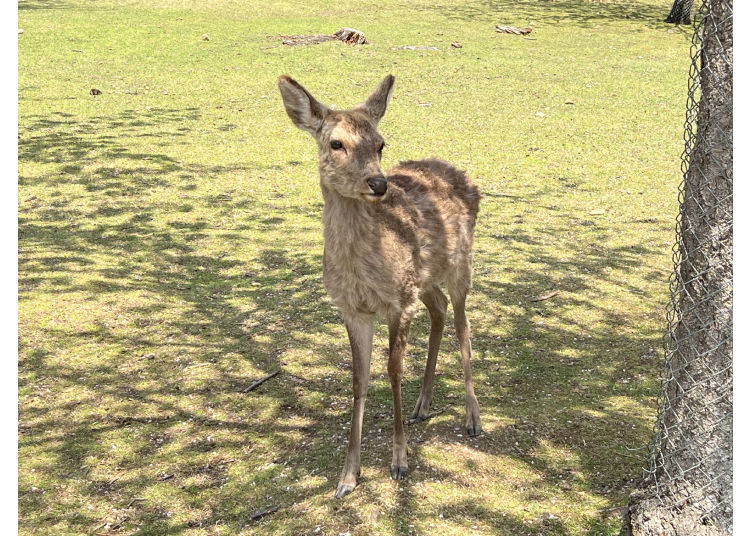
One Day Around Nara Park: Exploring Kasuga Taisha, Todai-ji, and Local Shopping Streets
- Written by: WESTPLAN
Just steps from Kintetsu-Nara Station, a charming shopping street leads the way to Nara Park, where a deer may casually wander into view around the corner—that’s your first impression of this iconic place. From Kasuga Taisha Shrine and Todai-ji Temple to the base of Mt. Wakakusa, this lush park is home to several World Heritage Sites and remains one of Nara’s must-see destinations.
Whether it’s the surprise of a deer “stealing” your senbei crackers or the quiet moments spent strolling between ancient temples and shrines, Nara Park offers a unique blend of peacefulness and historical depth. So when traveling in Kansai, don’t stop at Osaka and Kyoto—join LIVE JAPAN as we explore the picturesque heart of Nara and uncover its unmissable sights and walking routes.
(This article includes sponsored content)
- Table of Contents
-
- Must-Snap View: Kofukuji’s Five-Story Pagoda Reflected in Sarusawa Pond
- Kofukuji: A National Treasure Trove of Buddhist Statues
- Savor Local Flavors at Kasuga Ninai-jaya Tea House
- Kasuga Taisha: Built to Protect the Ancient Capital of Heijo-kyo
- Kasuga Taisha Museum: Home to National Treasures
- World Heritage Site Todai-ji: A Monument to Nara’s Buddhist Legacy
- Yoshikien: A Tranquil Japanese Garden Hidden Beside Todai-ji
- Nara National Museum: A Showcase of Japan’s Buddhist Art Heritage
- End Your Nara Trip on a Sweet Note Near Kintetsu-Nara Station
- Bonus Tip: Stay the Night—Recommended Hotels Around Nara
Must-Snap View: Kofukuji’s Five-Story Pagoda Reflected in Sarusawa Pond

Just east of the Sanjo-dori shopping street, Sarusawa Pond is an easy stroll from JR Nara Station’s east exit or from Kintetsu-Nara Station via the Higashimuki arcade. This 332-meter artificial pond dates back to the Nara period. The reflection of Kofukuji’s Five-Story Pagoda and surrounding willow trees on its calm surface creates one of the most iconic photo spots in Nara.
Every year on April 17, the temple holds the Hojoe, releasing carp and goldfish into the pond. During the autumn moon-viewing season, the elegant Uneme Matsuri features beautifully adorned boats gliding across the water.
-
Kofukuji Gojunoto (Five-Story Pagoda)興福寺五重塔
- Address Shibatsuji-cho, Nara City, Nara Prefecture
-
Nearest Station
20 minute walk from JR Yamatoji Line Nara Station; 5 minute walk from Kintetsu Nara Line Kintetsu Nara Station
- Phone Number 0742-22-0375
Hours: Open anytime
Kofukuji: A National Treasure Trove of Buddhist Statues

Kofukuji Temple is the head temple of the Hosso school of Buddhism, with origins dating back to 669, when it was first established in Kyoto by the wife of Fujiwara no Kamatari. After relocating to Fujiwara-kyo and being renamed Umayasaka-dera, the temple moved once more when the capital shifted to Nara. It was then renamed Kofukuji and flourished under the support of the imperial court and the powerful Fujiwara clan.
A key temple in both the Nara and Heian periods, Kofukuji remains a cultural landmark. Highlights include its iconic National Treasure—the Five-Story Pagoda—along with the Three-Story Pagoda and East Golden Hall. The temple also houses an extraordinary collection of Buddhist statuary, including the celebrated Ashura statue from the Tenpyo era, making it a true treasure trove for those interested in Buddhist art.

At the heart of Kofukuji stands the Central Golden Hall (Chukondo), which was finally reopened to the public in October 2018 after a 300-year absence. The hall has been destroyed by fire seven times throughout its history, making this reconstruction especially significant.
Inside, the principal object of worship is a statue of Shakyamuni Buddha, flanked by statues of the Medicine King and Medicine Superior Bodhisattvas—both designated Important Cultural Properties. Nearby, the South Octagonal Hall (Nan'endo) enshrines the Four Heavenly Kings, each a National Treasure.

The National Treasure Hall at Kofukuji recreates the original Nara-period dining hall and showcases a remarkable collection of Buddhist statues designated as National Treasures and Important Cultural Properties. Highlights include the Ashura statue—celebrated as one of the finest masterpieces of Nara-period sculpture—alongside the Eight Legions, fierce Nio guardians, and the playfully expressive Demon of Heavenly Light and Demon of Dragon Light.
Beneath the hall, the ruins of the original jikido remain preserved, offering a rare look into the temple’s ancient foundations.
-

-
Address
48 Noborioji-cho, Nara City, Nara Prefecture, 630-8213
View Map -
Nearest Station
Kintetsunara Station (Kintetsu-nara Line)
5 minutes on foot
- Phone Number 0742-22-7755
-
Address
48 Noborioji-cho, Nara City, Nara Prefecture, 630-8213
Savor Local Flavors at Kasuga Ninai-jaya Tea House

Operated directly by Kasuga Taisha Shrine, Kasuga Ninai-jaya sits along the shrine’s approach path, offering serene views of a seasonal garden right outside its windows. This charming tea house traces its roots back to the Edo period, when it was known for serving sweets and tea to worshippers.
Today, it’s known for its specialty dish—Manyo-gayu, a local rice porridge inspired by the ancient Manyoshu poetry collection. With over 50 seats in the garden area, it’s the perfect place to relax and enjoy a peaceful meal surrounded by blooming flowers year-round.

The tea house’s signature dish is the seasonal Manyo-gayu, a delicate white miso rice porridge infused with rich kombu dashi. Each month features a different topping inspired by poems from the Manyoshu, starting in January with seven-herb porridge, followed by seasonal ingredients like soybeans, rapeseed blossoms, cherry blossoms, and yam.
For a taste of Nara’s local flavors in one meal, try the Yamato Meibutsu Zen set, which includes Manyo-gayu, persimmon leaf sushi, and kudzu mochi.

Inspired by a traditional celebratory meal at Kasuga Taisha called Kagi no Outozen, this dish features somen noodles served with umeboshi and mustard—prepared according to ancient customs. The Kasuga Somen is a seasonal favorite, available only in summer, and recreates this elegant and refreshing tradition.
-
Kasuga Ninai-jaya Tea House春日荷茶屋
- Address 160 Kasuganocho, Nara City, Nara Prefecture
-
Nearest Station
Nearest station: From JR Yamatoji Line Nara Station or Kintetsu Nara Line Kintetsu Nara Station, take a bus to Kasuga Taisha Honden for about 11–15 minutes and get off at Kasuga Taisha Honden; alternatively, take the clockwise city loop bus for about 9–13 minutes, get off at Nara Kasugano International Forum Iraka-mae, then walk about 10 minutes
- Phone Number 0742-27-2718
・Hours: 10:30 AM–4:30 PM
・Closed: Mondays (Open daily in April–May and October–November)
Kasuga Taisha: Built to Protect the Ancient Capital of Heijo-kyo

Founded in 768 to safeguard Heijo-kyo and ensure the well-being of its people, Kasuga Taisha enshrines four deities: Takemikazuchi-no-Mikoto, Futsunushi-no-Mikoto, Amenokoyane-no-Mikoto, and Himegami—all of whom can be worshipped within the shrine grounds.
To commemorate the 1300th anniversary of the capital’s founding, the shrine began offering early morning worship experiences to the public. The tranquil atmosphere and beauty of the grounds at dawn create a truly special moment—highly recommended for visitors.

Within the grounds of Kasuga Taisha, you'll find many smaller shrines, including the Meoto Daikokusha—the only shrine in Japan dedicated to the married deities of Okuninushi-no-Mikoto and his wife.
This unique shrine is known for blessings in business prosperity, marital harmony, and especially matchmaking. Visitors often offer heart-shaped ema (wooden votive plaques) in hopes of finding true love.

According to legend, the deity Takemikazuchi-no-Mikoto, enshrined at Kasuga Taisha|, arrived from Kashima in present-day Ibaraki Prefecture riding a white deer. As a result, deer are revered as sacred messengers of the gods and are carefully protected and respected by the shrine.
Many of the shrine’s lucky charms and omikuji (fortune slips) are shaped like deer, with the most beloved being the adorable shika-mikuji—a small deer figurine holding a fortune slip in its mouth. With such a charming good luck token, it feels like good fortune is sure to follow!
-

-
Address
160, Kasuganocho, Nara-shi, Nara, 630-8212
View Map -
Nearest Station
Nara Station (JR Kansai Main Line / JR Yamatoji Line / JR Sakurai Line)
11 minutes by car
- Phone Number 0742-22-7788
-
Address
160, Kasuganocho, Nara-shi, Nara, 630-8212
Kasuga Taisha Museum: Home to National Treasures

After visiting the main hall of Kasuga Taisha, be sure to stop by the Kasuga Taisha Museum (Kokuhoden), which houses an extraordinary collection of sacred artifacts. The museum preserves 352 National Treasures and 971 Important Cultural Properties.
On the first floor, you’ll find the Taiko Drum Hall, featuring a pair of massive daidaiko drums used during sacred Bugaku performances at the Kasuga Wakamiya Festival—each standing 6.5 meters tall, the largest of their kind in active use in Japan. The second-floor gallery showcases another daidaiko from the Kamakura period, believed to have been donated by Minamoto no Yoritomo, as well as other rare ritual offerings made to the shrine’s deities—items you can only see here.

Another highlight of the Kasuga Taisha Museum is the immersive art space called Shingaki, designed to evoke the sacred spirit of Kasuga. One installation, Kannabi, is a 2-minute 30-second projection that uses a reflective water basin and overhead imagery to recreate the mystical atmosphere of Kasuga’s sacred forest. In the quiet, lush greenery appears, casting a serene and captivating glow.
Another piece, titled Kasuga, projects images of the shrine’s landscape—torii gates, deer along the approach path, and lanterns—onto a multi-layered lattice of iron frames. The shifting visuals create an almost otherworldly experience, as if stepping into the spiritual essence of Kasuga itself.
-
Kasuga Taisha Kokuhoden Museum国宝殿
- Address 奈良縣奈良市春日野町160
-
Nearest Station
・Nearest station: From JR Yamatoji Line Nara Station or Kintetsu Nara Line Kintetsu Nara Station, take a bus to Kasuga Taisha Honden for about 11–15 minutes and get off at Kasuga Taisha Honden; alternatively, take the clockwise city loop bus for about 9–13 minutes, get off at Kasuga Taisha Omotesando, then walk about 10 minutes
- Phone Number 0742-22-7788
・Hours: 10 AM–5 PM
・Admission: 500 yen
・Closed: During exhibit changes or temporarily as needed
World Heritage Site Todai-ji: A Monument to Nara’s Buddhist Legacy
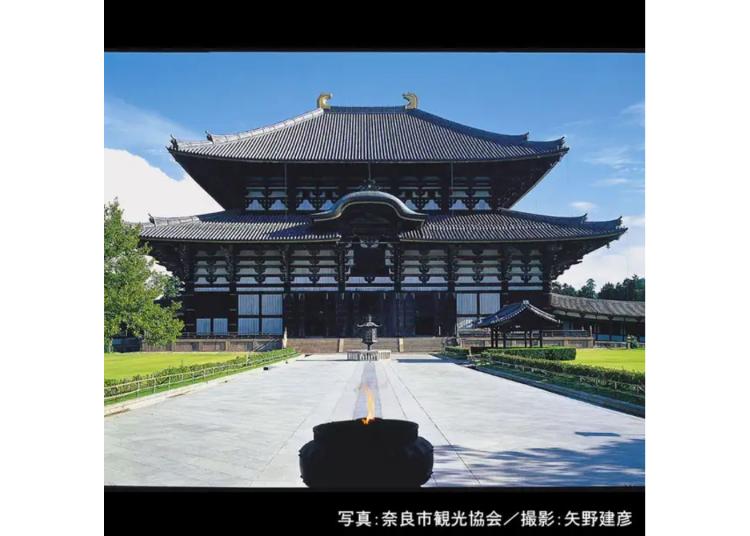
Built during the Nara period to pray for peace across the land, Todai-ji Temple stands as a grand testament to Japan’s Buddhist heritage. Its most iconic structure is the Daibutsuden (Great Buddha Hall), which houses the 15-meter-tall seated statue of Vairocana Buddha—known as the Nara Daibutsu. Housed in the world’s largest wooden building, the statue’s serene presence inspires awe and reverence.
Visitors also love trying the “pillar crawl” beneath one of the hall’s massive columns. It's said that if you can squeeze through the hole, you’ll be blessed with the same wisdom as the Great Buddha—no easy feat, but an incredibly rewarding one! The temple grounds also feature other notable sites like the Great South Gate and Nigatsudo Hall, offering a walk through time and a deep connection to centuries of Buddhist culture.
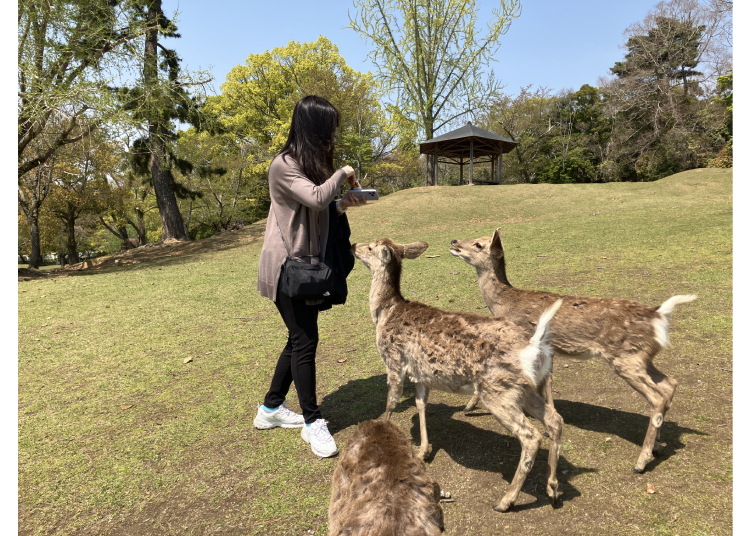
Outside Todai-ji Temple, you'll often spot deer leisurely roaming the grounds. You can buy shika senbei (deer crackers) from local vendors for 200 yen per pack.
Once the deer catch sight of the treats in your hand, expect to be quickly surrounded! At that point, there’s no use resisting—just hand over the snacks and enjoy the fun of feeding Nara’s famous friendly residents.
-

-
Address
406-1 Zoshicho, Nara City, Nara Prefecture, 630-8587
View Map -
Nearest Station
Kintetsunara Station (Kintetsu-nara Line)
20 minutes on foot
- Phone Number 0742-22-5511
-
Address
406-1 Zoshicho, Nara City, Nara Prefecture, 630-8587
- Great Buddha Hall: 800 yen for adults / 400 yen for elementary school students
Yoshikien: A Tranquil Japanese Garden Hidden Beside Todai-ji
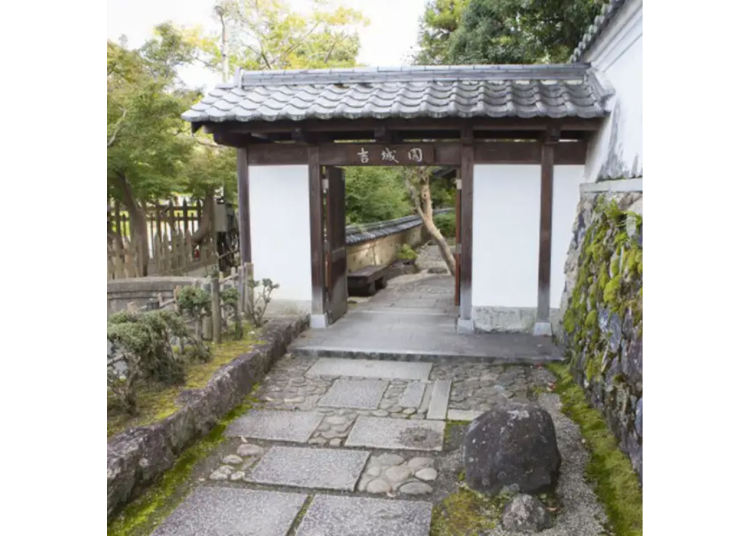
If you're looking to escape the crowds and quietly enjoy a garden view, Yoshikien—tucked beside Todai-ji—is the perfect retreat.
This traditional Japanese garden artfully combines three styles: a pond garden, dry landscape (kare-sansui), and a tea garden. While it may appear modest on a map, wandering through its layered scenery reveals a rich and varied landscape.
Each season brings a new charm—fresh greenery in spring, lush foliage in summer, fiery maples in autumn, and the subtle beauty of frost-kissed stones in winter. Relaxing on the wooden veranda of the garden's tatami room while watching the light and shadows shift across the garden offers a quiet, meditative moment.
With few visitors and a calm atmosphere, Yoshikien is an ideal place to rest and reflect after exploring Todai-ji.
-

-
Address
60-1, Noboriojicho, Nara-shi, Nara, 630-8213
View Map -
Nearest Station
Kintetsunara Station (Kintetsu-nara Line)
10 minutes on foot
- Phone Number 0742-22-5911
-
Address
60-1, Noboriojicho, Nara-shi, Nara, 630-8213
- Free of charge
Nara National Museum: A Showcase of Japan’s Buddhist Art Heritage
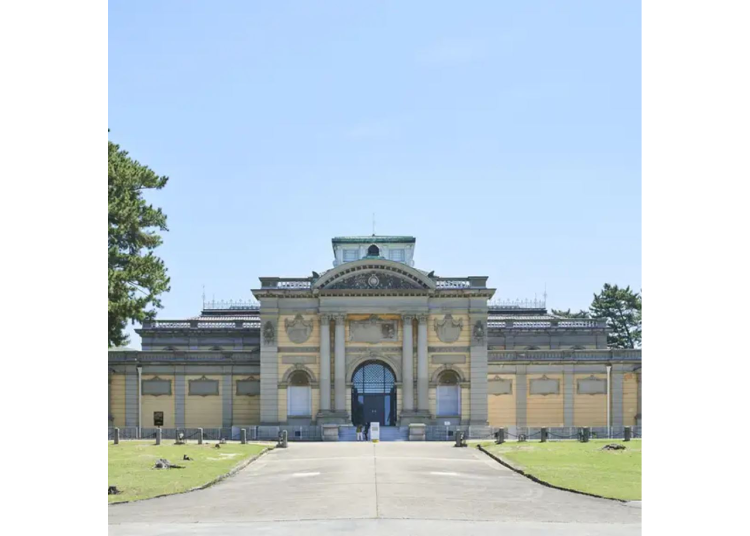
Located within Nara Park, the Nara National Museum was founded in the Meiji era and is dedicated to preserving and exhibiting Buddhist art. It's an ideal place to immerse yourself in the spiritual and artistic legacy of Japanese religious culture. The museum consists of two buildings: a Western-style historic wing and a sleek modern gallery. Its collections feature Buddhist statues, scriptures, and paintings sourced from ancient temples and shrines across Japan.
One of its most iconic events is the annual autumn Shosoin Exhibition, a limited-time display of treasures from the Shosoin repository—artifacts once used by emperors during the Nara period. These rare items reflect the influence of Silk Road culture and the fusion of Eastern and Western aesthetics. Even those unfamiliar with Buddhist art will be moved by the craftsmanship and history embedded in each piece—well worth taking the time to explore.
-

-
Address
50, Noboriojicho, Nara-shi, Nara, 630-8213
View Map -
Nearest Station
Kintetsunara Station (Kintetsu-nara Line)
15 minutes on foot
- Phone Number 050-5542-8600
-
Address
50, Noboriojicho, Nara-shi, Nara, 630-8213
- Permanent Exhibits: 700 yen for adults / 350 yen for university students / Free for high school students and younger (*Special exhibitions require separate admission)
End Your Nara Trip on a Sweet Note Near Kintetsu-Nara Station
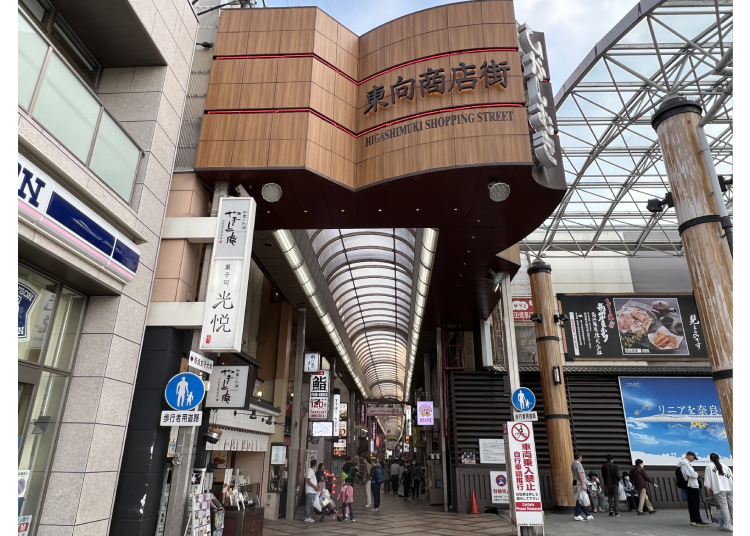
After your stroll through Nara Park, take some time to explore the area around Kintetsu-Nara Station before heading home. This lively neighborhood is full of shops selling deer-themed trinkets, lucky charms from local shrines, and traditional Japanese sweets.
Be sure to try kakinoha-zushi, a local specialty featuring sushi wrapped in persimmon leaves. It's easy to find at station kiosks, nearby supermarkets, or souvenir shops—and perfect as a snack on the train or back at your hotel.
Don’t miss shopping spots like “GOTO-CHI” and “Time’s Place Nara” right by the station, where you’ll find stylish goods and Nara-exclusive items—an ideal last stop for souvenirs and cute gifts.
Bonus Tip: Stay the Night—Recommended Hotels Around Nara
While it's possible to see the main sights of Nara Park in a day, spending a night here allows you to experience the area's ancient charm at a more relaxed pace.
We've selected a few hotels near JR Nara Station and Kintetsu-Nara Station that offer a touch of traditional Japanese atmosphere—perfect for immersing yourself in the spirit of Nara from morning to night.
-

-
Address
1-1-6 Omiyacho, Nara-shi, Nara, 630-8115
View Map -
Nearest Station
Nara Station (JR Kansai Main Line / JR Yamatoji Line / JR Sakurai Line)
4 minutes on foot
Vacancy search, reservation
-
from 11,990JPY 1room, 2adults
Check with our partner site as the latest rates, rate details, and guest room requirements may vary.
-
Address
1-1-6 Omiyacho, Nara-shi, Nara, 630-8115
-

-
Address
Sanjohonmachi 1-2, Nara, Nara, 630-8122
View Map -
Nearest Station
Nara Station (JR Kansai Main Line / JR Yamatoji Line / JR Sakurai Line)
1 minute on foot
Vacancy search, reservation
-
from 7,456JPY 1room, 2adults
Check with our partner site as the latest rates, rate details, and guest room requirements may vary.
-
Address
Sanjohonmachi 1-2, Nara, Nara, 630-8122
-

-
Address
40 Nobori Ojicho, Nara-shi, Nara, 630-8213
View Map -
Nearest Station
Kintetsunara Station (Kintetsu-nara Line)
4 minutes on foot
-
Address
40 Nobori Ojicho, Nara-shi, Nara, 630-8213
-
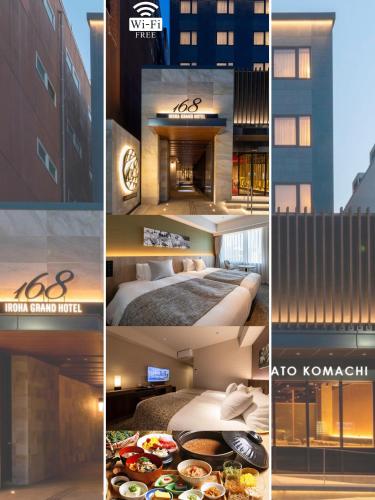
-
Address
30 Konishi-cho, Nara, Nara, 630-8226
View Map -
Nearest Station
Kintetsunara Station (Kintetsu-nara Line)
2 minutes on foot
Vacancy search, reservation
-
from 7,251JPY 1room, 2adults
Check with our partner site as the latest rates, rate details, and guest room requirements may vary.
-
Address
30 Konishi-cho, Nara, Nara, 630-8226
-

-
Address
46-1 Takamacho, Nara-shi, Nara, 630-8241
View Map -
Nearest Station
Kintetsunara Station (Kintetsu-nara Line)
3 minutes on foot
-
Address
46-1 Takamacho, Nara-shi, Nara, 630-8241
-

-
Address
Takabatake-cho 1113-3 , Nara, Nara, 630-8301
View Map -
Nearest Station
Kintetsunara Station (Kintetsu-nara Line)
11 minutes on foot
Vacancy search, reservation
-
from 20,064JPY 1room, 2adults
Check with our partner site as the latest rates, rate details, and guest room requirements may vary.
-
Address
Takabatake-cho 1113-3 , Nara, Nara, 630-8301
Whether it’s the quiet majesty of World Heritage temples, the lush greenery of the park, or the soothing moments shared with Nara’s gentle deer, the area around Nara Park offers a travel pace unlike Kyoto’s bustling charm. Here, you won’t find crowded streets or flashy commercial zones—instead, ancient temples blend seamlessly with nature, and local snacks await in laid-back shopping streets.
From Kintetsu-Nara Station, follow a route through Todai-ji Temple, Kasuga Taisha, Yoshikien Garden, and the Nara National Museum, then finish your stroll by browsing for souvenirs or relaxing with a dessert near the station. This day trip beautifully weaves together history, nature, and local life.
If you’ve already explored the lively elegance of Kyoto, consider setting aside a day to immerse yourself in Nara’s peaceful atmosphere. You might just find your own personal moment of Japan—whether it’s in a quiet gaze shared with a deer or among the timeless ruins of the Asuka era.
To wrap things up, we’ve also gathered a few easy one-day tours in Nara, Osaka, and Kyoto—perfect for those looking for a laid-back Kansai experience!
Kiko Matsuda, Keiko Kimura, Risa Tsushi, and a team of female writers familiar with Kansai. We love eating, drinking and traveling! We share fun information based on our experiences.
- Area
- Category
*Prices and options mentioned are subject to change.
*Unless stated otherwise, all prices include tax.
Popular Tours & Activitiess
Recommended places for you
-

Kanzenkoshitsuyakinikutabehodai Gyugyu Paradise Sannomiya
Yakiniku
Kobe, Sannomiya, Kitano
-
Goods

Yoshida Gennojo-Roho Kyoto Buddhist Altars
Gift Shops
Nijo Castle, Kyoto Imperial Palace
-

Jukuseiniku-to Namamottsuarera Nikubaru Italian Nikutaria Sannomiya
Izakaya
Kobe, Sannomiya, Kitano
-

ISHIDAYA Hanare
Yakiniku
Kobe, Sannomiya, Kitano
-

Kambei Sannomiyahonten
Yakiniku
Kobe, Sannomiya, Kitano
-

Osaka Aquarium KAIYUKAN
Zoos, Aquariums & Botanical Gardens
USJ, Nanko Port
-
Ad

Recharge and Relax with a Healing Getaway at Kamenoi Hotel Toba
-
Ad

Discover Timeless Beauty: Kimono-en, a Web Magazine Exploring the Spirit of Kimono
-
Ad

Café Bahnhof in Osaka: The home-roasted coffee that captivated G20 leaders!
-

Everything You Need to Know About teamLab Biovortex Kyoto (2025 Insider Guide)
by: Wemmy Chau
-

Curious About Sake? I Visited a Sake Brewery in Japan and Here's What I Learned
-

November Events in Kansai: Fun Festivals, Food, and Things to Do in Kyoto & Osaka
Inspiration for Accommodations
-

Spacious Family Hotel in Namba: 20 Comfortable Stays for Family Fun
-

Charming Hotels to Enjoy the Spectacular Views of Arashiyama's Autumn Leaves from Your Room
-

Experience Stunning Views of Osaka Castle from Private Spaces: Top Hotels Near Osaka Castle
-

Recommended by Visitors! Arashiyama's Best-Rated Hotels
-

Family-Friendly Universal Studios Japan Hotel with Excellent Access
-

Enjoy a Comfortable Stay in Osaka! 10 Hotels with Convenient Airport Shuttle Services
-

Top 10 Recommended Hotels Near Namba Station with Great Access
-

Enjoy Night Views from Your Room! Recommended Hotels in Namba Area
-

38 Best Things to Do in Kyoto: See, Eat, and Shop Your Way Through Japan's Cultural Capital
-

Top 3 Restaurants: Best Sushi in Dotonbori According to a Local Food Critic
-

Universal Studios Japan: Guide to Osaka's Giant Theme Park Attractions!
by: WESTPLAN
-

Tokyo Train Map: Your Essential Guide to Subways and Railways
-

Kyoto Momiji: 5 Stunning Places to See Fall Colors in Kyoto
-

Complete Guide to Buying Japanese Medicine in Japan: Phrases and Vocabulary You Need to Know
- #best gourmet Osaka
- #things to do Osaka
- #what to do in kyoto
- #what to bring to japan
- #best gourmet Kyoto
- #new years in Osaka
- #what to buy in nanba
- #Visiting Osaka
- #onsen tattoo friendly arima
- #daiso
- #Visiting Kyoto
- #best japanese soft drinks
- #japanese fashion culture
- #japanese convenience store snacks
- #japanese nail trends



















